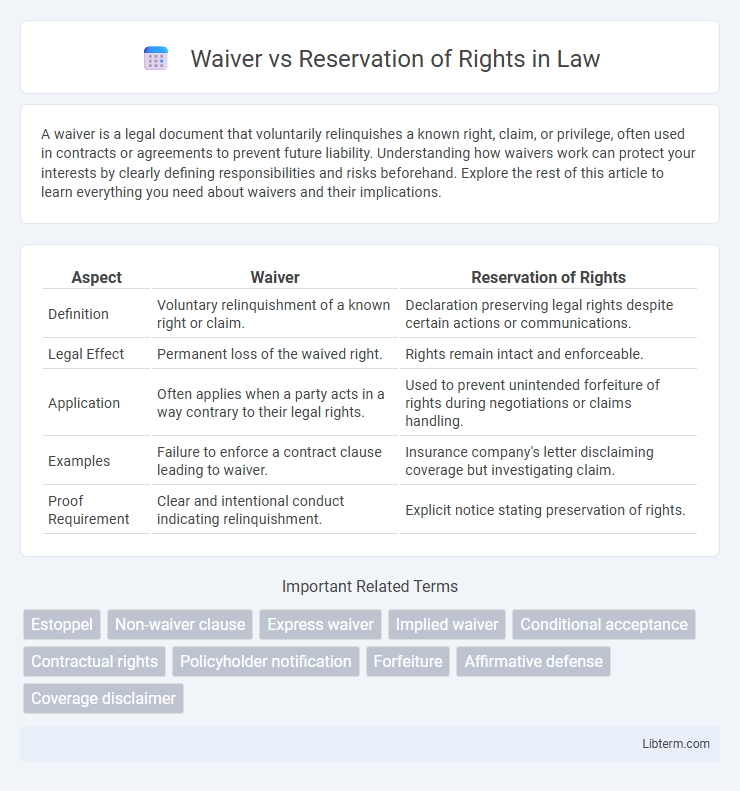A waiver is a legal document that voluntarily relinquishes a known right, claim, or privilege, often used in contracts or agreements to prevent future liability. Understanding how waivers work can protect your interests by clearly defining responsibilities and risks beforehand. Explore the rest of this article to learn everything you need about waivers and their implications.
Table of Comparison
| Aspect | Waiver | Reservation of Rights |
|---|---|---|
| Definition | Voluntary relinquishment of a known right or claim. | Declaration preserving legal rights despite certain actions or communications. |
| Legal Effect | Permanent loss of the waived right. | Rights remain intact and enforceable. |
| Application | Often applies when a party acts in a way contrary to their legal rights. | Used to prevent unintended forfeiture of rights during negotiations or claims handling. |
| Examples | Failure to enforce a contract clause leading to waiver. | Insurance company's letter disclaiming coverage but investigating claim. |
| Proof Requirement | Clear and intentional conduct indicating relinquishment. | Explicit notice stating preservation of rights. |
Introduction to Waiver and Reservation of Rights
Waiver refers to the voluntary relinquishment or abandonment of a known right or claim, often occurring when a party fails to enforce a contractual provision or legal entitlement. Reservation of rights is a formal declaration that a party intends to preserve its legal rights despite taking certain actions, such as making partial payments or acknowledging a claim. Understanding the distinction between waiver and reservation of rights is crucial in contract law and insurance claims to prevent unintended loss of rights or obligations.
Defining Waiver in Legal Context
Waiver in a legal context refers to the voluntary relinquishment or surrender of a known right, claim, or privilege, often explicitly expressed or implied through conduct. It results in the party giving up the right to enforce a specific legal benefit or defense at a future time. Understanding waiver is crucial to distinguishing it from a reservation of rights, where a party maintains the ability to enforce rights while acknowledging a particular situation.
Understanding Reservation of Rights
Understanding Reservation of Rights involves recognizing that it is a formal statement by an insurer clarifying that coverage is not being denied but is reserved pending further investigation or legal determination. This ensures the insurer maintains its ability to deny claims later if it finds policy exclusions or other valid reasons. Reservation of Rights protects both the insurer's interests and the policyholder's right to a defense while the claim is evaluated.
Key Differences: Waiver vs Reservation of Rights
Waiver refers to the voluntary relinquishment of a known right, which results in the permanent loss of that right, while reservation of rights allows a party to retain their legal claims or defenses despite taking a particular action. In waiver, the party intentionally abandons specific rights, often through explicit or implicit conduct, whereas reservation of rights explicitly preserves the party's ability to enforce those rights in the future. Understanding these distinctions is critical in contract law and insurance claims, where waiver can prevent future enforcement, but reservation of rights maintains legal protections.
Legal Implications of Waiver
A waiver involves the voluntary relinquishment of a known right, which legally prevents the party from later asserting that right in court. Courts scrutinize waivers closely, requiring clear, explicit intent to waive rights to avoid ambiguity and preserve legal fairness. Failure to establish a valid waiver can result in the continuation of rights and defenses that the reserving party intended to forego.
Significance of Reservation of Rights Notices
Reservation of Rights notices play a crucial role in preserving an insurer's ability to deny coverage while still investigating a claim or providing a defense. By issuing these notices, insurers avoid unintentionally waiving coverage defenses and maintain their legal right to contest claims in the future. The significance lies in balancing prompt claim handling with safeguarding contractual and legal rights throughout the claims process.
Common Scenarios: Waiver in Action
In insurance claims, waiver commonly occurs when an insurer fails to enforce specific policy conditions, such as timely filing requirements, effectively relinquishing the right to deny coverage based on those conditions. For example, if an insurance company continues to process a late claim without objection, it may be deemed to have waived the right to reject the claim for tardiness. Similarly, during contract negotiations, partial or informal acceptance of terms without insisting on strict adherence can result in a waiver, impacting the parties' ability to later enforce those original rights.
Practical Uses of Reservation of Rights
Reservation of rights allows an insurer to continue investigating a claim without waiving its rights to deny coverage later, preserving legal defenses in complex or questionable cases. It is commonly used when there is uncertainty about policy applicability or potential coverage exclusions, enabling the insurer to avoid premature acceptance of liability. This practical approach ensures that insurers maintain strategic flexibility while complying with contractual and legal obligations.
Risks and Consequences of Each Approach
Waiver involves an intentional relinquishment of a known right, which can lead to permanent loss of that right if not properly documented. Reservation of rights allows a party to maintain their legal claims or defenses while taking a specific action, but failing to clearly communicate this reservation can result in unintended waiver or estoppel. Understanding the risks tied to ambiguous language and inconsistent conduct is crucial to prevent adverse legal outcomes and preserve contractual or legal protections.
Choosing the Right Approach: Best Practices
When deciding between waiver and reservation of rights, legal professionals should carefully evaluate the implications of each approach on future claims and liability exposure. Waiving a right can result in permanently relinquishing specific claims, while reserving rights preserves the option to enforce those claims later, making clear communication and documentation essential for protecting interests. Best practices include consulting thoroughly with legal counsel, explicitly stating intentions in writing, and assessing the impact on contractual obligations and dispute resolution strategies.
Waiver Infographic

 libterm.com
libterm.com